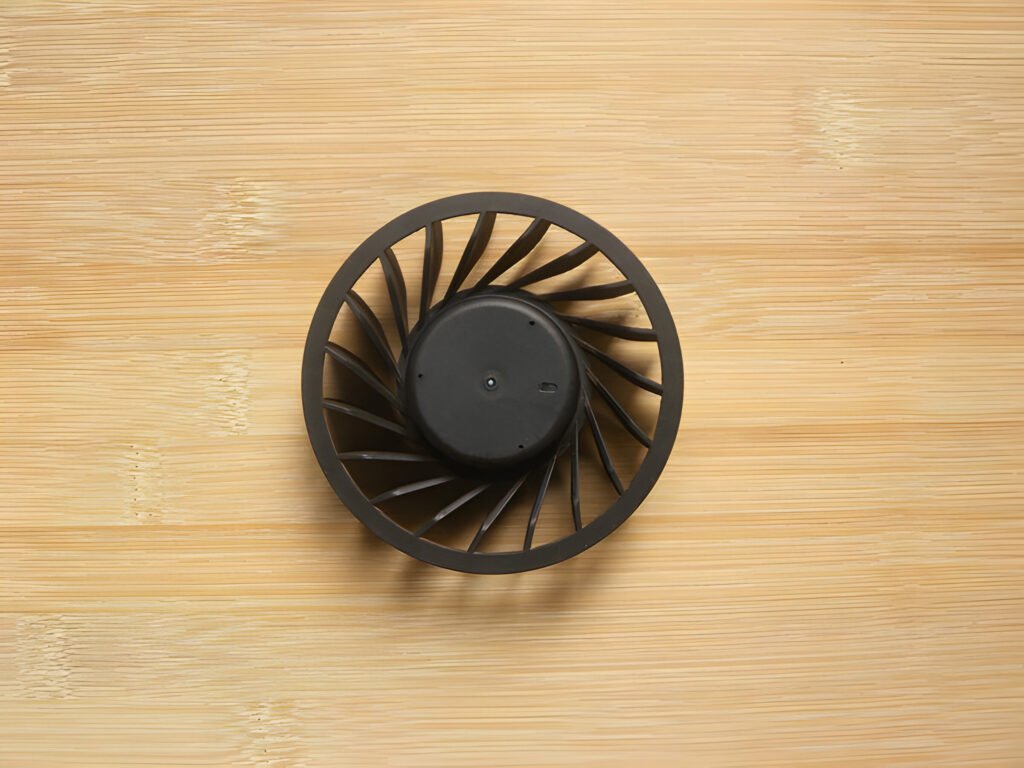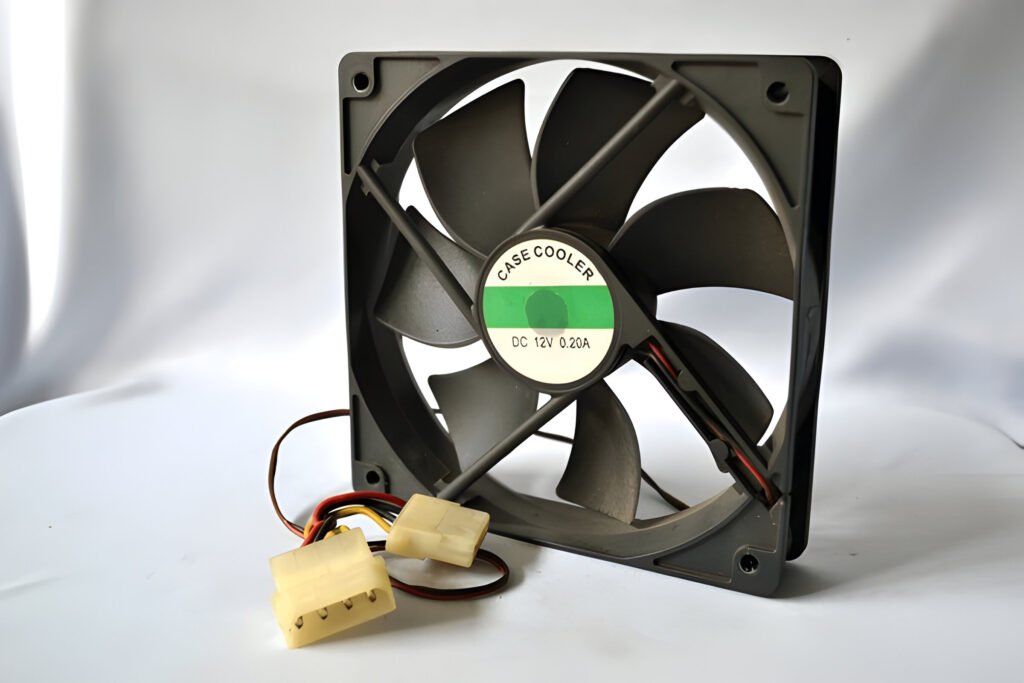Axial Fans Vs Centrifugal Fans: What’s the Difference
Axial fans move air linearly, while centrifugal fans use rotating impellers to change airflow direction.
Read More

Vane axial fans are a type of air movement device that consists of a cylindrical housing containing a propeller or fan blade assembly. The fan blades are mounted on a central hub and are designed to rotate around an axis parallel to the airflow direction. This axial configuration allows for efficient air movement and high-volume flow rates.
One of the key features of vane axial fans is the presence of guide vanes, which are stationary blades positioned either before or after the rotating fan blades. These guide vanes help to straighten and direct the airflow, reducing turbulence and improving overall efficiency. The vanes also contribute to increased static pressure, enabling vane axial fans to overcome resistance in ducted systems.
Vane axial fans are known for their compact design and ability to move large volumes of air while maintaining a relatively small footprint. They are commonly used in a wide range of applications, including ventilation systems, cooling towers, and industrial processes that require high-volume air movement.
Vane axial flow fans operate on a simple principle. A cylindrical casing houses a central hub with attached blades. The rotating hub creates a pressure difference, forcing air axially through the fan.
Guide vanes distinguish vane axial fans. These stationary blades, positioned before or after the rotating blades, straighten airflow. This reduces turbulence and increases efficiency.
The motor spins the hub and blades when activated. Rotation creates a low-pressure area in front and a high-pressure area behind the fan. This pressure difference drives air through the fan. Guide vanes then direct the airflow, reducing swirl and converting rotational energy into useful airflow.
The impeller forms the core of a vane axial fan, driving its performance. It comprises a hub and blades designed for efficient air movement. Impellers typically feature 4 to 16 blades.
The shaft in a vane axial fan acts as the central axis, connecting the impeller to the motor and transmitting rotational power. It must withstand high rotational speeds and impeller weight while maintaining alignment.
The hub forms the central component of a vane axial fan, serving as the mounting point for blades or vanes. This cylindrical or conical structure attaches to the shaft and rotates to drive fan operation.
Electric motors power vane axial fans, converting electrical energy into mechanical energy to rotate the impeller.
Vane axial fan casings form the outer shell, housing and protecting internal components. These casings withstand operational pressures and temperatures.
The cylindrical casing shape optimizes airflow. A smooth interior surface minimizes turbulence and friction. Inlet and outlet openings at each end often feature flanges for ductwork connection.


Vane axial fans efficiently move large air volumes at medium to high static pressures. Their design incorporates a propeller-like impeller and guide vanes, enabling high efficiency when dealing with significant pressure differentials. These fans handle static pressures up to 5 inches of water column while maintaining high airflow rates.
Vane axial fans feature a compact, inline configuration that maximizes space efficiency. These fans integrate directly into ductwork or piping systems, eliminating external housings or mounting frames.
Vane axial fans operate more quietly than other industrial fan types. Their design incorporates guide vanes that streamline airflow, reducing turbulence and noise levels.
These fans maintain lower decibel levels even at high speeds due to their efficient aerodynamic design. The blade shape and arrangement minimize air resistance and vibration, cutting through air with minimal disturbance.
Adjustable pitch blades in vane axial fans offer precise performance optimization. Users can fine-tune airflow by modifying blade angles without altering rotational speed.
Direct Drive
Direct drive fans mount the impeller directly on the motor shaft. This eliminates belts and pulleys, creating a compact and efficient design. Direct drive configurations excel in constant speed operations and require less maintenance. They produce less noise and vibration due to fewer moving parts.
Belt Drive
Belt drive fans use a belt and pulley system to connect the motor and impeller. This design allows flexible motor placement and easy speed adjustments through pulley size changes. Belt drive configurations are suitable when the motor needs isolation from the airstream or when fine-tuning fan performance is necessary. However, they demand more maintenance for belt wear and tension adjustments.
Adjustable Pitch Blades
Adjustable pitch blades allow angle changes to optimize airflow and pressure for specific needs. This adaptability suits applications with varying operating conditions. Users can maintain efficiency across different scenarios by adjusting blade pitch, potentially reducing energy consumption and operating costs.
Fixed Pitch Blades
Fixed pitch blades have a set angle that remains constant after installation. They feature a simpler design and lower upfront costs. Fixed pitch fans suit applications with consistent airflow requirements. Their durability stems from fewer moving parts, resulting in reduced maintenance needs over time.


| Feature | Vane Axial Fans | Centrifugal Fans | Propeller Fans | Tube Axial Fans |
|---|---|---|---|---|
| Airflow Direction | Parallel to fan axis | Perpendicular to fan inlet | Parallel to fan axis | Parallel to fan axis |
| Pressure | Medium to high | High | Low | Low to medium |
| Efficiency | High | Medium to high | Low to medium | Medium to high |
| Noise Level | Low to medium | Medium to high | Low to medium | Low to medium |
| Size and Weight | Compact and lightweight | Larger and heavier | Compact and lightweight | Compact and lightweight |
| Durability | High | High | Low to medium | Medium to high |
| Maintenance | Low | Medium to high | Low to medium | Low to medium |
| Cost | Medium to high | High | Low to medium | Medium |
| Typical Applications | HVAC systems, industrial processes, cooling towers | Industrial processes, air pollution control, material handling | General ventilation, exhaust systems, cooling | HVAC systems, process cooling, ventilation |
| Airflow Volume | Medium to high | Low to high | High | Medium to high |
| Pressure Sensitivity | Low to medium | Low | High | Medium |
| Installation Flexibility | High | Medium to high | High | High |


Airflow rate is a critical factor in vane axial fan selection. Determine the precise air volume needed within a specific timeframe. Measure this rate in cubic feet per minute (CFM) or cubic meters per hour (m³/h).
Insufficient airflow rates fail to meet ventilation needs. Excessive rates lead to energy waste and noise.
Static pressure is a key consideration when selecting vane axial fans. It represents the resistance the fan must overcome to move air through a system. Higher static pressure requires more power from the fan to maintain desired airflow rates.
Efficiency directly impacts energy consumption and operational costs in vane axial fan selection. Evaluate fan efficiency by comparing air power output to electrical power input. Higher efficiency fans move the same air volume with less energy, reducing long-term operating expenses.
Vane axial fan noise reduction requires consideration of blade design, motor type, and operating speed.
Vane axial fans excel in applications with limited space due to their compact design. Larger fans move more air but require more space.
Vane axial fans typically last 10-15 years with proper maintenance.
Vane axial fans can be used in hazardous environments if specially designed and certified as explosion-proof. These models must meet strict safety standards to prevent ignition risks in flammable atmospheres.
Regular maintenance for vane axial fans includes:
Noise reduction options for vane axial fans include acoustic enclosures, vibration isolators, sound-absorbing materials, low-noise blade designs, and variable speed controls.
Vane axial fans typically offer higher energy efficiency compared to other HVAC systems. They provide superior performance with lower power consumption, resulting in reduced energy costs when incorporated into HVAC setups.
Guide vanes are used on axial fans to straighten and direct airflow, increasing efficiency and reducing turbulence. They help convert the rotational energy imparted by the fan blades into useful straight-line airflow.
Vane axial fans typically have efficiencies ranging from 65% to 85%, depending on factors such as blade design, guide vane geometry, motor efficiency, and operating conditions.